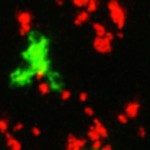Link to Pubmed [PMID] – 15710650
J. Exp. Med. 2005 Feb;201(4):579-90
The lineage relationships of central-memory T cells (T(CM)) cells and effector-memory T cells (T(EM)), as well as their homeostasis and recall capacities, are still controversial. We investigated these issues in a murine model using two complementary approaches: T cell receptor repertoire analysis and adoptive transfer experiments of purified H-Y-specific T(CM) and T(EM) populations. Repertoire studies showed that approximately two thirds of T(CM) and T(EM) clones derived from a common naive precursor, whereas the other third was distinct. Both approaches highlighted that T(CM) and T(EM) had drastically distinct behaviors in vivo, both in the absence of antigen or upon restimulation. T(CM) clones were stable in the absence of restimulation and mounted a potent and sustained recall response upon secondary challenge, giving rise to both T(CM) and T(EM), although only a fraction of T(CM) generated T(EM). In contrast, T(EM) persisted for only a short time in the absence of antigen and, although a fraction of them were able to express CD62L, they were unable to mount a proliferative response upon secondary challenge in this model.

